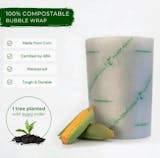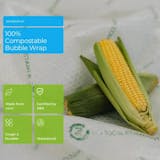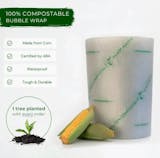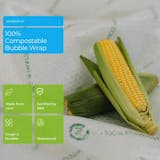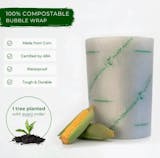Composting Packaging - How to Compost Our Compostable Packaging
At Zero Waste Co, we are committed to reducing non-biodegradable waste and providing eco-friendly solutions, like composting packaging. Our compostable packaging is designed to break down naturally and contribute to a healthier environment. In this guide, we will explain how to properly compost our packaging to ensure maximum effectiveness.
Step 1: Gather Your Compostable Packaging
Collect all the compostable packaging materials you have received from Zero Waste Co. This may include mailers, satchels, or any other packaging labeled as compostable.
Step 2: Remove Any Non-Compostable Components
Before composting, make sure to remove any non-compostable components from the packaging. This may include stickers, labels, or plastic windows. These items should be disposed of separately according to your local waste management guidelines.
Step 3: Cut or Shred the Packaging

To speed up the composting process, it is recommended to cut or shred the compostable packaging into smaller pieces. This will help it break down more quickly and evenly in the compost pile.
Step 4: Create or Locate a Compost Pile

If you already have a compost pile or bin, locate it in your garden or designated composting area. If you don't have one, you can create a compost pile by layering organic materials such as food scraps, yard waste, and now, your compostable packaging.
Step 5: Add the Compostable Packaging to the Pile
Place the cut or shredded compostable packaging into the compost pile. Make sure to mix it well with the other organic materials to ensure proper decomposition.
Step 6: Maintain Moisture and Aeration

Compost piles require moisture and aeration to break down effectively. Regularly check the moisture level of your compost pile and add water if necessary. Additionally, turn or mix the pile every few weeks to provide oxygen and promote decomposition.
Step 7: Monitor the Composting Process
Composting can take several months to a year, depending on various factors such as temperature, moisture, and the size of the compost pile. Monitor the progress of the composting process and make adjustments as needed.
Step 8: Use the Compost

Once the composting process is complete, the compostable packaging will have transformed into nutrient-rich compost. Use this compost to enrich your garden soil, nourish plants, or as a top dressing for your lawn.
By following these steps, you can effectively compost our compostable packaging and contribute to a more sustainable future. If you have any questions or need further assistance, please don't hesitate to contact us at hello@zerowasteco.com.au. Together, we can make a difference!
Composting packaging is a sustainable way to dispose of materials and reduce waste. In this guide, we’ll cover how you can effectively compost our compostable packaging. By following these steps, you can transform packaging into valuable compost that enriches the soil.
To get started with composting packaging, you need to understand what compostable packaging is. Compostable packaging is made from materials that break down naturally into non-toxic components, typically within 90 days. These materials include plant-based products, bioplastics, and paper. When composted, they turn into nutrient-rich soil, which can be used for gardening and farming.
The first step in composting packaging is to check if it is marked as compostable. Look for labels that say 'compostable' or 'biodegradable.' However, not all biodegradable items are compostable. For successful composting, the packaging must meet specific composting standards. Once you have identified compostable packaging, the next step is to prepare it for composting. This may involve removing any non-compostable elements like plastic stickers or coatings.
After preparing the packaging, you need to find the right composting environment. This could be a backyard compost bin, a community composting facility, or a commercial composting site. The key factors for effective composting packaging are heat, moisture, oxygen, and microorganisms. Compostable packaging usually requires higher temperatures to break down efficiently, so commercial composting facilities are ideal for faster decomposition.
If you are using a home composting system, make sure to mix the compostable packaging with other organic waste, like food scraps and yard waste. This will help balance the carbon to nitrogen ratio, which is crucial for the decomposition process. Turn the compost regularly to aerate the pile and maintain the right moisture levels. The packaging will break down over time, and you should see significant decomposition within a few months.
Composting packaging helps reduce landfill waste and supports a circular economy. By composting our compostable packaging, you contribute to environmental sustainability. Plus, you gain valuable compost that can improve soil health and support plant growth. It's a win-win situation for you and our planet.
In conclusion, composting packaging is an effective way to manage waste sustainably. By following the steps outlined above, you can successfully compost our compostable packaging and make a positive impact on the environment. So next time you have compostable packaging, remember these tips and start composting!











